
The entrance piece to the recent conference ‘Tanz über Gräben’ at the Radialsystem V was for me certainly L. Chétouane’s choreography of ‘Sacré Sacre du Printemps’ and its re-staging at the HAU in this context. It was now shown in the much wider horizon of this really multi-facetted conference, reminding 100 years of the first staging of ‘Le Sacre du Printemps’ in Paris in 1913 and G. Brandstetter’s opening note located the piece in the context of its time. Among them were Freud’s publication of ‘Totem and Taboo’ and the constitution of othering, that means the inclusion and exclusion through the definition of ‘primitivism’. The Rite of Spring, still is often listed as “primitivist” due to its programmatic subject of the pagan rite: the sacrifice(1), as stated in Wikipedia.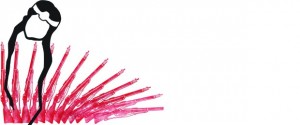
Let’s start though with the contemporary: Chétouane once said after a presentation of the performance of ‘Sacré Sacre du Printemps’ in 2012 –‘it is a different piece each time’. It was not that obvious to me when I saw it twice last year, but it was clearly visible this time and eventually not only due to the felt absence of the dancer An Kaler. This is not meant as an affront to Mikael Marklund, in contrary, as one will see in the following, it is more likely due to common audience behavior. Indeed the slightly different group of dancers, which performed this time, created a different mix, and made apparent how important direct interaction is for and in Chétouane’s works.
The piece started seemingly as usual, but then soon it became clear that some interference pattern intervened on the longer term the development of getting into a more structured movement pattern in the opening part. A sort of culmination of disorientation forced the dancers to look irritated and like searching for each other, sometimes even standing like wondering for a short moment, but then soon again the group started to emerge into a nervous, at points almost aggressive play of energy.
These signs re/occurred occasionally throughout the piece – making themselves perceptible in shouts or seen and felt in sudden more ‘classical’ dance moves. The high loaded energy also led to an unusual amount of bodily contact and one-to-one interaction. I recall when seeing this piece a year ago, I could count the two or three times of direct body contact. This time the crowd members were running into each other, almost looking for instant exchange, single dancers turning in amazement and of curiosity, displaying a perceptible and sensual disorientation. A bewildering – at points breaking into wildness and shout-outs, which nevertheless had its caring side. When one of the dancers crushed into the wall, near the point where I was sitting, two others of the group close to her were immediately indicating care gestures, so eventually that could not be seen by the audience further back.
What was so different this time? The dancers felt entirely close, almost private, they seemed to have become friends. Is it due to seeing them more than once, to have worked with their video, with excerpts from an interview of L. Chétouane – or my own changing body senses and perception?
Nevertheless, I did miss for a while the more precise moves, as well as the intensity of looking, I had experienced in the former stagings of ‘Sacré Sacre du Printemps’. But it also led to ask myself, what does the visibility of the look, which tried to catch the ‘space looking back’, and which last time became sensible in a slight tremor of their heads, mean. Was it a justified demand, when the dancers are already at another point of their bodily experience, to ask them to keep that as a gesture. And, if done so, would it not become just the ‘technic’ N. Möller-Schöll cast out as a potential banality, as a pure signal? Interestingly it was him, who also remarked on the absence of this phenomenon.
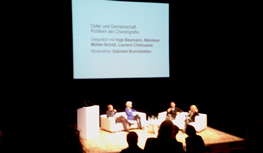
But in this current staging of ‘Sacré Sacre du Printemps’ the dancers managed to find back into new arrangements, and later also to known patterns, even into repetitive moves, enabling a felt relief for the audience, though visibly causing exhaustion for the dancers. ‘Finally something lasting and to be read’, the audience seemed to sigh, which is due to our minds desperate neuronal search for a pattern, any pattern(2) as J.Lehrer writes, but it is also needed to distinguish disorder.
These sometimes hard to stand moments of actual interaction, as they open up to the undefined, a space for the new, unknow, or as the program leaflet wrote, the unrepresentable were definitely felt, obviously not only by me, concluding from G. Brandstetter description of her viewing experience of the piece in the discussion.
Almost literally N. Möller-Schöll interpreted in his contribution to the symposium the thin line between the art’s/artist’s failure and the necessity of a risk to fail which has to be accessed when questioning what is at stake. In fact in context with the history of especially this piece – the subject of the symposium: Nijinsky’s, Diaghilev’s and Strawinsky’s ‘Le Sacre du Printemps’ this statement occurs almost ironic or may be just again as the confirmation which seems to be so blatant, that one barely dares to bring it forward, that the most inspiring pieces of art never come forward in accordance to the governing habits of knowing and perceiving of their time.
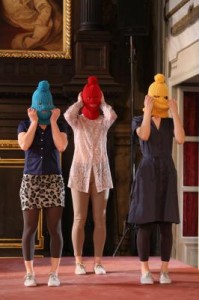
J. Halberstam took the part to outline not only the queerness of this Le Sacre du Printemps in its time, but interpreted it as a general queer piece. She established this argument not only due to the main actors sexual orientation, but in its general disaligning with the common streamlines, and for that she reminded rightfully that the uproar the piece first caught was a very conservative one. From the lack of hierarchy in Stravinsky’s music evolved a notion of poly-rhythm yet unknow at the time and created what H.G.Kessler defined as the ‘shock of the new’, which found re/occurrence in the line Halberstam drew to the Punk movement in 1976. Halberstam referred here especially to M.Greil’s comment that the moment of shock, brings people to their feet, a point that Nijinsky almost literally brought on stage. The real shock of ‘Le Sacre du Printemps’ certainly was that the ‘savage’ other is rendered at the center of society itself, as Nicola Gess stated very clearly the next day. Through this insight ‘Le Sacre du Printemps’ locates itself – in both music as well as Nijinsky’s choreography – at the liminal and shifting barrier between nature and culture, between the human and the non-human. A liminal border still in shift, that creates the touchy and still highly actual point of this piece.
At the moment of its first staging, it felt like touching a blank nerve, already virulent as undercurrent of the times, as Halberstam remarked that nevertheless ‘colonialism took its last gasp’, the notion of the other as such just became redefined in different terms to resettle a certain understanding. The order wasn’t yet allowed to shift that much to let the other as the ‘other-within’ in. The other, she stated, just became externalized in new hetero-normative or different (primitive) and racist (aberrant) terminologies. To touch the other, to be with the other, see the other within oneselves own notions is still the task ‘Le Sacre du Printemps’ challenges, as Chétouane stated. That is what makes the piece so actual.
The quite common view, that J.Lehrer repeats, that this dance (Le Sacre du Printemps) was about the absence of order(3), is certainly not true. Also disorder needs as its opposite order to be able to become visible. And disorder or disorientation can only happen when content refuses to conform to our learned expectations(4). For S. Ahmed’s dis/orientation emerges from the crossing or aberrant lines that interrupt the space of social construction, which usually is defined by a set of the directions “that allow things to appear in a certain wayâ€.(5) It is the way of direction, the orientation towards and around something which defines and eventually opens up a new line of movement. The mind and the body in its intuitive way of sensing the other’s move has just that minimal open, that liminal chance that disorientation offers, to read anew and differently.
And here I am crossing the line that turns me around and back onto Chétouane’s dancers who tendered interpretation with great courage towards the audience and played in their own staging quite risky – including the risk to stumble, to fail, to fall, to retreat to known moves, to combine new ones that even surprise themselves. Especially to demand the same from each other, and further in their most challenging task to ask the audience to follow further into the open amazement of what is possible that can be experienced without giving in to the demand of emerging patterns, that would need to immediately fix what occurs into a representational state.
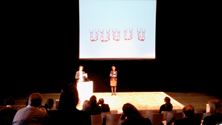
Bodily exhaustion brings forward a different expression, an ambivalence we are normally not aware about. It is hard to distinguish, and most likely even harder to allow it happen especially in front of an audience. It are these queer moments, that need to be allowed to happen that in Ahmed’s sense grant a slipping object to appear and have it pass through, in the unknowable length of its duration(7). And this is the object of the other, the other as the other, the new, the unknown, the queer. At this point here I do not agree to the connection S.Foellmer made between the notion of the grotesque and the queer to describe the movements of in ‘Le Sacre du Printemps’, despite her otherwise excellent work on the Gert Valeska. Certainly the queer establishes an aberrant line/direction, but to define it as grotesque or establishing it within this relation today, it becomes a willful ‘ornamental’ decoration, that is limited to the confinements of the bizarre.(8).
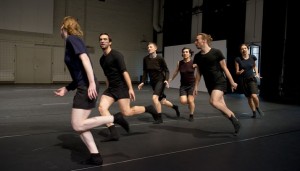
Interaction is a risky proof or to use the wider, but more specific term of K. Barad’s intra-action, which defines time and space of a certain occurrence that eventually emerges outside confined judgment, but carries its own ethics inherently. The non-human then is no longer the infantile, as Adorno complains about, but it is our next and neighbor. We are part of it, are in and of our non-human environment and define ourselves in interaction with it. At the core of ‘Le Sacre du Printemps’ may be just these raw roots of ourselves, which are so scary to be looked at. Or to use some expressions of J.Assmann: the Primeval as a breakthrough into the unprecedented, the long overdue untested.
footnotes:
(1) http://en.wikipedia.org/wiki/Primitivism (19.11.13)
(2) J.Lehrer, Proust was a Neuroscientist,, p.130
(3) Ibid. p. 121
(4) Ibid; p .133
(5) Sara Ahmed, Queer phenomenology, Duke University Press Books, 2006, p. 165
(6) HAU, program, my translation
(7) Sara Ahmed, Queer phenomenology, Duke University Press Books, 2006, p. 167; 171-172
(8) http://en.wikipedia.org/wiki/Grotesque (19.11.13)
